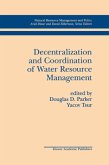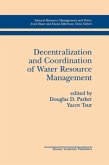- Broschiertes Buch
- Merkliste
- Auf die Merkliste
- Bewerten Bewerten
- Teilen
- Produkt teilen
- Produkterinnerung
- Produkterinnerung
The molecular theory of water and aqueous solutions has only recently emerged as a new entity of research, although its roots may be found in age-old works. The purpose of this book is to present the molecular theory of aqueous fluids based on the framework of the general theory of liquids. The style of the book is introductory in character, but the reader is presumed to be familiar with the basic properties of water [for instance, the topics reviewed by Eisenberg and Kauzmann (1969)] and the elements of classical thermodynamics and statistical mechanics [e.g., Denbigh (1966), Hill (1960)] and…mehr
Andere Kunden interessierten sich auch für
![Sustainable Processes for the Removing of Heavy Metals from Aqueous Solutions Sustainable Processes for the Removing of Heavy Metals from Aqueous Solutions]() Sustainable Processes for the Removing of Heavy Metals from Aqueous Solutions83,99 €
Sustainable Processes for the Removing of Heavy Metals from Aqueous Solutions83,99 €![Against the Current: Privatization, Water Markets, and the State in Chile Against the Current: Privatization, Water Markets, and the State in Chile]() Carl J. BauerAgainst the Current: Privatization, Water Markets, and the State in Chile77,99 €
Carl J. BauerAgainst the Current: Privatization, Water Markets, and the State in Chile77,99 €![Against the Current: Privatization, Water Markets, and the State in Chile Against the Current: Privatization, Water Markets, and the State in Chile]() Carl J. BauerAgainst the Current: Privatization, Water Markets, and the State in Chile81,99 €
Carl J. BauerAgainst the Current: Privatization, Water Markets, and the State in Chile81,99 €![Decentralization and Coordination of Water Resource Management Decentralization and Coordination of Water Resource Management]() Decentralization and Coordination of Water Resource Management116,99 €
Decentralization and Coordination of Water Resource Management116,99 €![Diplomacy on the Jordan Diplomacy on the Jordan]() Munther J. HaddadinDiplomacy on the Jordan242,99 €
Munther J. HaddadinDiplomacy on the Jordan242,99 €![Decentralization and Coordination of Water Resource Management Decentralization and Coordination of Water Resource Management]() Douglas D. Parker / Yacov Tsur (Hgg.)Decentralization and Coordination of Water Resource Management121,99 €
Douglas D. Parker / Yacov Tsur (Hgg.)Decentralization and Coordination of Water Resource Management121,99 €![Experimental and Computational Solutions of Hydraulic Problems Experimental and Computational Solutions of Hydraulic Problems]() Experimental and Computational Solutions of Hydraulic Problems116,99 €
Experimental and Computational Solutions of Hydraulic Problems116,99 €-
-
-
The molecular theory of water and aqueous solutions has only recently emerged as a new entity of research, although its roots may be found in age-old works. The purpose of this book is to present the molecular theory of aqueous fluids based on the framework of the general theory of liquids. The style of the book is introductory in character, but the reader is presumed to be familiar with the basic properties of water [for instance, the topics reviewed by Eisenberg and Kauzmann (1969)] and the elements of classical thermodynamics and statistical mechanics [e.g., Denbigh (1966), Hill (1960)] and to have some elementary knowledge of probability [e.g., Feller (1960), Papoulis (1965)]. No other familiarity with the molecular theory of liquids is presumed. For the convenience of the reader, we present in Chapter 1 the rudi ments of statistical mechanics that are required as prerequisites to an under standing of subsequent chapters. This chapter contains a brief and concise survey of topics which may be adopted by the reader as the fundamental "rules of the game," and from here on, the development is very slow and detailed.
Hinweis: Dieser Artikel kann nur an eine deutsche Lieferadresse ausgeliefert werden.
Hinweis: Dieser Artikel kann nur an eine deutsche Lieferadresse ausgeliefert werden.
Produktdetails
- Produktdetails
- Verlag: Springer / Springer US / Springer, Berlin
- Artikelnr. des Verlages: 978-1-4615-8704-0
- 1974
- Seitenzahl: 492
- Erscheinungstermin: 17. Februar 2013
- Englisch
- Abmessung: 235mm x 155mm x 27mm
- Gewicht: 746g
- ISBN-13: 9781461587040
- ISBN-10: 1461587042
- Artikelnr.: 41322021
- Herstellerkennzeichnung Die Herstellerinformationen sind derzeit nicht verfügbar.
- Verlag: Springer / Springer US / Springer, Berlin
- Artikelnr. des Verlages: 978-1-4615-8704-0
- 1974
- Seitenzahl: 492
- Erscheinungstermin: 17. Februar 2013
- Englisch
- Abmessung: 235mm x 155mm x 27mm
- Gewicht: 746g
- ISBN-13: 9781461587040
- ISBN-10: 1461587042
- Artikelnr.: 41322021
- Herstellerkennzeichnung Die Herstellerinformationen sind derzeit nicht verfügbar.
1. Introduction and Prerequisites.- 1.1. Introduction.- 1.2. Notation.- 1.3. Classical Statistical Mechanics.- 1.4. Connections between Statistical Mechanics and Thermodynamics.- 1.5. Basic Distribution Functions in Classical Statistical Mechanics.- 1.6. Ideal Gas.- 1.7. Pair Potential and Pairwise Additivity.- 1.8. Virial Expansion and van der Waals Equation.- 2. Molecular Distribution Functions.- 2.1. Introduction.- 2.2. The Singlet Distribution Function.- 2.3. Pair Distribution Function.- 2.4. Pair Correlation Function.- 2.5. Features of the Radial Distribution Function.- 2.6. Further Properties of the Radial Distribution Function....- 2.7. Survey of the Methods of Evaluating g(R).- 2.8. Higher-Order Molecular Distribution Functions.- 2.9. Molecular Distribution Functions (MDF) in the Grand Canonical Ensemble.- 3. Molecular Distribution Functions and Thermodynamics.- 3.1. Introduction.- 3.2. Average Values of Pairwise Quantities.- 3.3. Internal Energy.- 3.4. The Pressure Equation.- 3.5. The Chemical Potential.- 3.6. Pseudo-Chemical Potential.- 3.7. Entropy.- 3.8. Heat Capacity.- 3.9. The Compressibility Equation.- 3.10. Local Density Fluctuations.- 3.11. The Work Required to Form a Cavity in a Fluid.- 3.12. Perturbation Theories of Liquids.- 4. Theory of Solutions.- 4.1. Introduction.- 4.2. Molecular Distribution Functions in Mixtures; Definitions.- 4.3. Molecular Distribution Functions in Mixtures; Properties.- 4.4. Mixtures of Very Similar Components.- 4.5. The Kirkwood-Buff Theory of Solutions.- 4.6. Symmetric Ideal Solutions; Necessary and Sufficient Conditions.- 4.7. Small Deviations from Symmetric Ideal (SI) Solutions.- 4.8. Dilute Ideal (DI) Solutions.- 4.9. Small Deviations from Dilute Ideal Solutions.- 4.10. A Completely Solvable Example.- 4.11. StandardThermodynamic Quantities of Transfer.- 5. Generalized Molecular Distribution Functions and the Mixture-Model Approach to Liquids.- 5.1. Introduction.- 5.2. The Singlet Generalized Molecular Distribution Function...- 5.3. Illustrative Examples of GMDF's.- 5.4. Pair and Higher-Order GMDF's.- 5.5. Relations between Thermodynamic Quantities and GMDF's..- 5.6. The Mixture-Model (MM) Approach; General Considerations.- 5.7. The Mixture-Model Approach to Liquids; Classifications Based on Local Properties of the Molecules.- 5.8. General Relations between Thermodynamics and Quasi component Distribution Functions (QCDF).- 5.9. Reinterpretation of Some Thermodynamic Quantities Using the Mixture-Model Approach.- 5.10. Some Thermodynamic Identities in the Mixture-Model Approach.- 6. Liquid Water.- 6.1. Introduction.- 6.2. Survey of Properties of Water.- 6.3. The Radial Distribution Function of Water.- 6.4. Effective Pair Potential for Water.- 6.5. Virial Coefficients of Water.- 6.6. Survey of Theories of Water.- 6.7. A Prototype of an Interstitial Model for Water.- 6.8. Application of an Exact Two-Structure Model (TSM).- 6.9. Embedding ad hoc Models for Water in the General Framework of the Mixture-Model Approach.- 6.10. A Possible Definition of the "Structure of Water".- 6.11. Waterlike Particles in Two Dimensions.- 6.12. Waterlike Particles in Three Dimensions.- 6.13. Conclusion.- 7. Water with One Simple Solute Particle.- 7.1. Introduction.- 7.2. Survey of Experimental Observations.- 7.3. "Hard" and "Soft" Parts of the Dissolution Process.- 7.4. Application of a Two-Structure Model.- 7.5. Application of an Interstitial Model.- 7.6. The Problem of Stabilization of the Structure of Water.- 7.7. Application of a Continuous Mixture-Model Approach.- 7.8. Conclusion.-8. Water with Two or More Simple Solutes. Hydrophobic Interaction (HI).- 8.1. Introduction.- 8.2. Survey of Experimental Evidence on Hydrophobic Interaction.- 8.3. Formulation of the Problem of Hydrophobic Interaction (HI).- 8.4. A Possible Connection between HI and Experimental Quantities.- 8.5. An Approximate Connection between HI and Experimental Quantities.- 8.6. Further Experimental Data on HI.- 8.7. Generalizations.- 8.8. Hydrophobic Interaction at Zero Separation.- 8.9. Hydrophobic Interaction at More Realistic Distances.....- 8.10. Entropy and Enthalpy of Hydrophobic Interaction.- 8.11. Hydrophobic Interaction and Structural Changes in the Solvent.- 8.12. Simulations.- 8.13. Conclusion.- 9. Appendix.- 9-A. Rotational Partition Function for a Rigid Asymmetric Molecule.- 9-B. Functional Derivative and Functional Taylor Expansion.- 9-C. The Ornstein-Zernike Relation.- 9-D. The Percus-Yevick Integral Equation.- 9-E. Solution of the Percus-Yevick (PY) Equation.- 9-F. The Chemical Potential in the T, P9 N Ensemble.- 9-G. The Chemical and the Pseudo-Chemical Potential in a Lattice Model.- Glossary of Abbreviations.- References.
1. Introduction and Prerequisites.- 1.1. Introduction.- 1.2. Notation.- 1.3. Classical Statistical Mechanics.- 1.4. Connections between Statistical Mechanics and Thermodynamics.- 1.5. Basic Distribution Functions in Classical Statistical Mechanics.- 1.6. Ideal Gas.- 1.7. Pair Potential and Pairwise Additivity.- 1.8. Virial Expansion and van der Waals Equation.- 2. Molecular Distribution Functions.- 2.1. Introduction.- 2.2. The Singlet Distribution Function.- 2.3. Pair Distribution Function.- 2.4. Pair Correlation Function.- 2.5. Features of the Radial Distribution Function.- 2.6. Further Properties of the Radial Distribution Function....- 2.7. Survey of the Methods of Evaluating g(R).- 2.8. Higher-Order Molecular Distribution Functions.- 2.9. Molecular Distribution Functions (MDF) in the Grand Canonical Ensemble.- 3. Molecular Distribution Functions and Thermodynamics.- 3.1. Introduction.- 3.2. Average Values of Pairwise Quantities.- 3.3. Internal Energy.- 3.4. The Pressure Equation.- 3.5. The Chemical Potential.- 3.6. Pseudo-Chemical Potential.- 3.7. Entropy.- 3.8. Heat Capacity.- 3.9. The Compressibility Equation.- 3.10. Local Density Fluctuations.- 3.11. The Work Required to Form a Cavity in a Fluid.- 3.12. Perturbation Theories of Liquids.- 4. Theory of Solutions.- 4.1. Introduction.- 4.2. Molecular Distribution Functions in Mixtures; Definitions.- 4.3. Molecular Distribution Functions in Mixtures; Properties.- 4.4. Mixtures of Very Similar Components.- 4.5. The Kirkwood-Buff Theory of Solutions.- 4.6. Symmetric Ideal Solutions; Necessary and Sufficient Conditions.- 4.7. Small Deviations from Symmetric Ideal (SI) Solutions.- 4.8. Dilute Ideal (DI) Solutions.- 4.9. Small Deviations from Dilute Ideal Solutions.- 4.10. A Completely Solvable Example.- 4.11. StandardThermodynamic Quantities of Transfer.- 5. Generalized Molecular Distribution Functions and the Mixture-Model Approach to Liquids.- 5.1. Introduction.- 5.2. The Singlet Generalized Molecular Distribution Function...- 5.3. Illustrative Examples of GMDF's.- 5.4. Pair and Higher-Order GMDF's.- 5.5. Relations between Thermodynamic Quantities and GMDF's..- 5.6. The Mixture-Model (MM) Approach; General Considerations.- 5.7. The Mixture-Model Approach to Liquids; Classifications Based on Local Properties of the Molecules.- 5.8. General Relations between Thermodynamics and Quasi component Distribution Functions (QCDF).- 5.9. Reinterpretation of Some Thermodynamic Quantities Using the Mixture-Model Approach.- 5.10. Some Thermodynamic Identities in the Mixture-Model Approach.- 6. Liquid Water.- 6.1. Introduction.- 6.2. Survey of Properties of Water.- 6.3. The Radial Distribution Function of Water.- 6.4. Effective Pair Potential for Water.- 6.5. Virial Coefficients of Water.- 6.6. Survey of Theories of Water.- 6.7. A Prototype of an Interstitial Model for Water.- 6.8. Application of an Exact Two-Structure Model (TSM).- 6.9. Embedding ad hoc Models for Water in the General Framework of the Mixture-Model Approach.- 6.10. A Possible Definition of the "Structure of Water".- 6.11. Waterlike Particles in Two Dimensions.- 6.12. Waterlike Particles in Three Dimensions.- 6.13. Conclusion.- 7. Water with One Simple Solute Particle.- 7.1. Introduction.- 7.2. Survey of Experimental Observations.- 7.3. "Hard" and "Soft" Parts of the Dissolution Process.- 7.4. Application of a Two-Structure Model.- 7.5. Application of an Interstitial Model.- 7.6. The Problem of Stabilization of the Structure of Water.- 7.7. Application of a Continuous Mixture-Model Approach.- 7.8. Conclusion.-8. Water with Two or More Simple Solutes. Hydrophobic Interaction (HI).- 8.1. Introduction.- 8.2. Survey of Experimental Evidence on Hydrophobic Interaction.- 8.3. Formulation of the Problem of Hydrophobic Interaction (HI).- 8.4. A Possible Connection between HI and Experimental Quantities.- 8.5. An Approximate Connection between HI and Experimental Quantities.- 8.6. Further Experimental Data on HI.- 8.7. Generalizations.- 8.8. Hydrophobic Interaction at Zero Separation.- 8.9. Hydrophobic Interaction at More Realistic Distances.....- 8.10. Entropy and Enthalpy of Hydrophobic Interaction.- 8.11. Hydrophobic Interaction and Structural Changes in the Solvent.- 8.12. Simulations.- 8.13. Conclusion.- 9. Appendix.- 9-A. Rotational Partition Function for a Rigid Asymmetric Molecule.- 9-B. Functional Derivative and Functional Taylor Expansion.- 9-C. The Ornstein-Zernike Relation.- 9-D. The Percus-Yevick Integral Equation.- 9-E. Solution of the Percus-Yevick (PY) Equation.- 9-F. The Chemical Potential in the T, P9 N Ensemble.- 9-G. The Chemical and the Pseudo-Chemical Potential in a Lattice Model.- Glossary of Abbreviations.- References.








